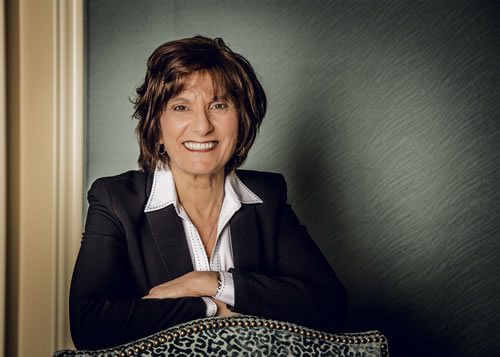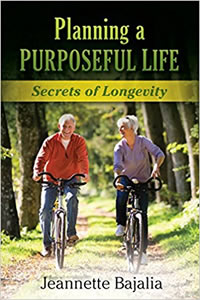She had just retired from a 38-year corporate career at age 55 and had taken a lump sum payout from her pension plan. She was combining it with the dollars in her 401K plan in an attempt to find a financial advisor that could help her recover the more than $250,000 she had willingly spent from her own retirement fund for her mother’s long-term care and still live the kind of lifestyle she desired.
After five interviews with advisors with impeccable credentials and glowing recommendations, she was still searching.
Jeannette Bajalia was frustrated.
She couldn’t connect with an advisor that understood she sought more than just a transactional relationship. She wanted an advisor that would select the product vehicles and facilitate the financial transactions after a “lifestyle plan” was first tailored.
“I personally walked away feeling so underserved as a professional woman,” Bajalia recalled. “I felt so disrespected and felt demoralized. I realized that I was asking them for what they did not understand. I was asking for a retirement plan and they were trying to sell me investments.”
There is indeed a large difference between those two approaches to financial advising, she said.
It’s the impetus behind Bajalia creating the Jacksonville, Florida-based, Woman’s Worth®. As the company’s CEO, Bajalia combines helping women improve and maintain their emotional and physical health, along with their financial needs, as a comprehensive approach to the gender she believes is underserved by her industry.  Bajalia knows women’s needs go unmet by other financial advisors on a regular basis. She is on a mission to change that, she said.
Bajalia knows women’s needs go unmet by other financial advisors on a regular basis. She is on a mission to change that, she said.
“The industry needs to stop treating women as a little niche that it can possibly serve,” Bajalia said. “They are the market; they are not just some niche.”
According to statistics and Bajalia’s own personal experience, along with what she has witnessed take place in other families, women make 80 percent of the purchasing choices in the current market.
As baby boomers age and husbands die in unprecedented numbers, women are taking control of increasing amounts of wealth. Estimates vary from report to report and study to study, but most agree that at least two-thirds of American wealth will be controlled by women within the next two decades.
It’s no secret that women view money and money matters much differently than men do.
The deep, vast abyss separating the gender viewpoints is often the punchline in a successful comedian’s stand-up routine. Our society routinely mocks the routine economic spats dotting the lives of married couples. We laugh at it and nod our heads.
Yet, while understanding that men and women have different approaches to financial matters, the bulk of the financial services industry still allows itself to operate under a blanket service model that is supposed to make everyone underneath it feel warm, cozy and secure, but does not do so.
At least not in Bajalia’s estimation.
“The financial industry is predominantly full of male advisors speaking the financial language of a left brain,” she said. “I love men. Don’t get me wrong. But they do not speak the same financial language as women do. Women process what money means and does for them very, very differently than men do.”
Women tend to view investing as a way to preserve their wealth as compared to the male view of investing as a way to increase their wealth – and even dominate against other men by having more. Men tend to be more willing to take risks, or at least risks that offer greater reward and failure than the ones women will take.
“Women – especially widows – want to know how they can protect their lifestyle and not become a financial burden on their children. They ask, ‘how do I manage to not end up penniless?’” Bajalia said.
How today’s mature women was raised to view money is at the heart of the female perspective. It’s a twist on the old adage: who you are now is where you were when.
Bajalia remembers believing as a teenager that her financial success was tied to finding the right guy and getting married. This was her experience even though she went to college, got a degree and began a career. Yet, still in her mind, her financial success was tied to her relationship with a man.
That all changed when she was 26 years old and her father died unexpectedly putting her in the position of being the financial provider for her mother and her great aunt.
She had a graduate degree in her chosen career field, but she did not understand the language of the financial industry.
“Here I was: not married and providing the sole support for two family members,” she said with a knowing laugh.
Three decades later when Bajalia decided to begin a second career in the financial services industry, that experience – and the recollection of the anxiety and confusion she felt trying to map out a strategy for herself, her mother and her great aunt – has provided not just a guide book, but also the emotional reminders that keep her work open to the specific needs of women.
Bajalia knows a larger percentage of widows live on incomes below the nationally-delineated poverty line. It is a big part of why she has no minimum requirement for investable assets for clients.
“I am going to help them,” she said. “As long as God keeps bringing them to my door, I am going to help them.”
Of course, she is able to do so because other clients of her fee-based firm are in that high net worth category that so much of the financial services industry courts.
Bajalia’s overall professional goal is to take the complexity out of the “mumbo jumbo” of the financial industry by educating her clients what that complexity means in terms of daily living, and planning not just for tomorrow, but for years in advance.
She isn’t in a hurry with her clients.
“If it takes two visits, or three visits or four or more visits to talk through their specific financial issues, then that is what I do,” she said “My relationships with clients cannot be merely transactional based. Each person absorbs the information differently and, thus, we walk the pace that the person sitting across the table from us needs to walk at.”
Bajalia knows a bit about staying in it for the long haul.
Her mother lived to age 93; her great aunt to 100 years of age.  Fulfilling her commitment to their care by keeping them in her home to age in place until death is what she considers to be her greatest success in life.
Fulfilling her commitment to their care by keeping them in her home to age in place until death is what she considers to be her greatest success in life.
“I made that commitment to my mother and my great aunt and it is indeed the greatest accomplishment in my life and now the push that has made me go where I now am professionally serving women and helping them remain secure in their financial lives as they age,” Bajalia said. “I recognized at age 55 that there had to be more and better ways for women to be served.”
Today, Bajalia is ten years into her second career. Technically, she is a financial advisor, but she prefers the title of life advisor.
She chuckles when discussing the fact that people ask why at age 66 she is still working so much.
“They ask me, ‘why are you doing all this crazy stuff, why aren’t you enjoying your own retirement?’” she said.
Oh, she is ... she is enjoying this latter half of her life because she believes what she is doing to educate women in their own financial language is making a difference and setting a new precedent for future generations.
“There is still a very long way to go in this,” she said. “As long as there are women out there that need my help, I will keep on working with them as long as I possibly can.”
Learn more about Jeannette Bajalia and Woman’s Worth® online at www.womans-worth.com






